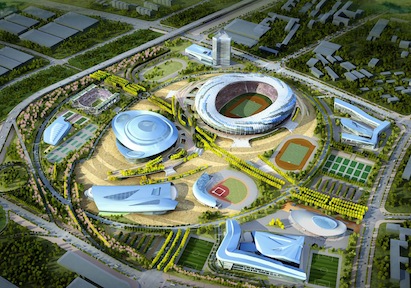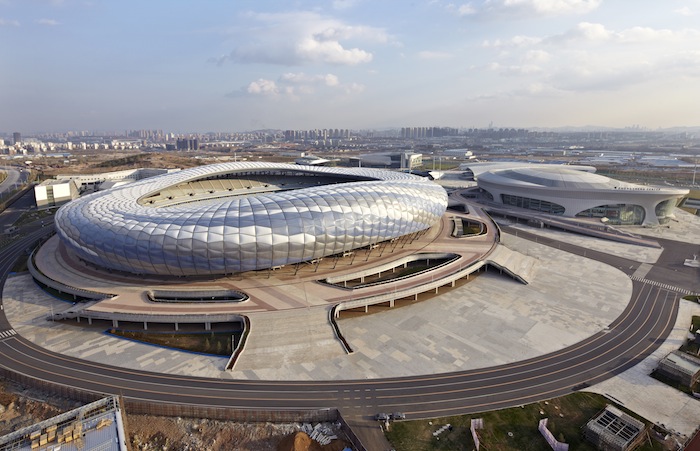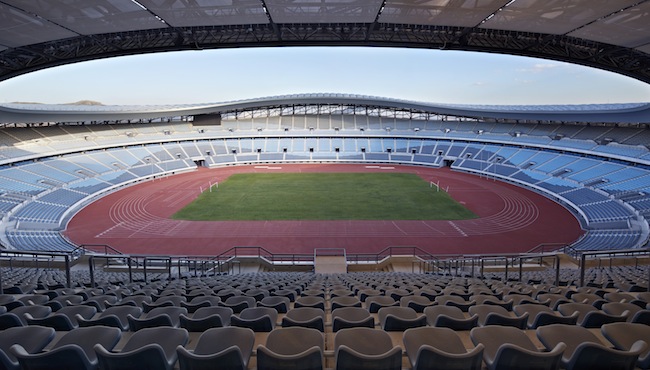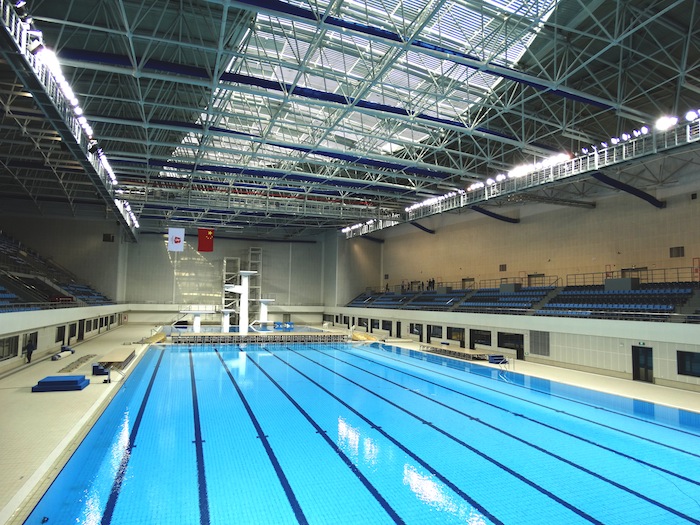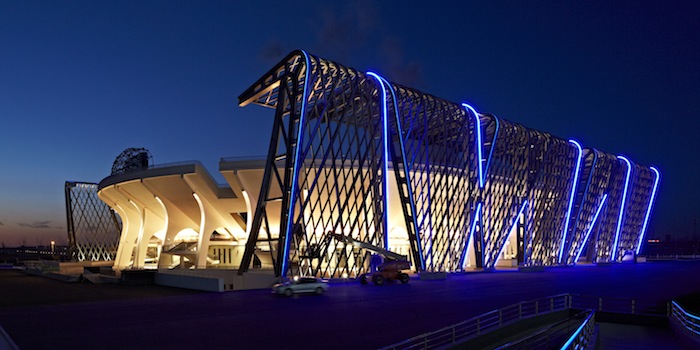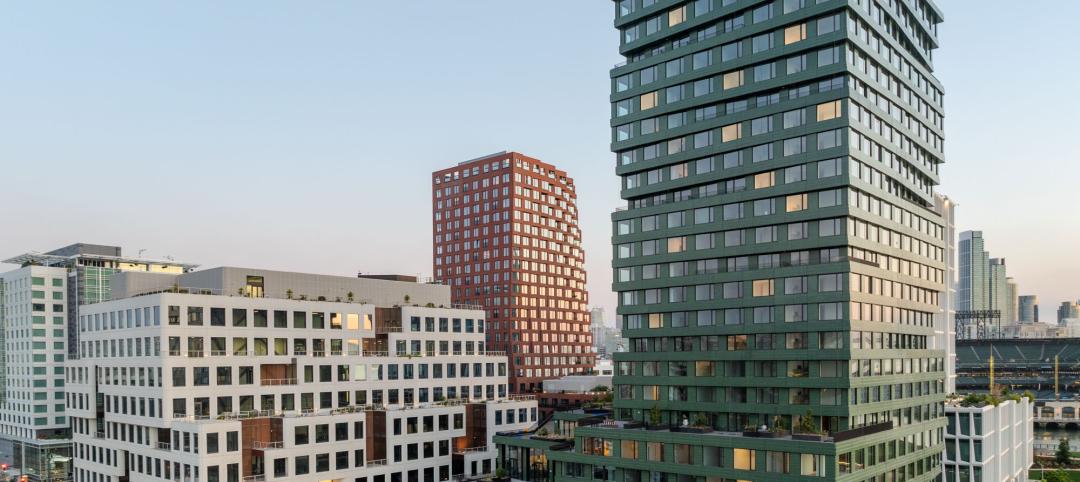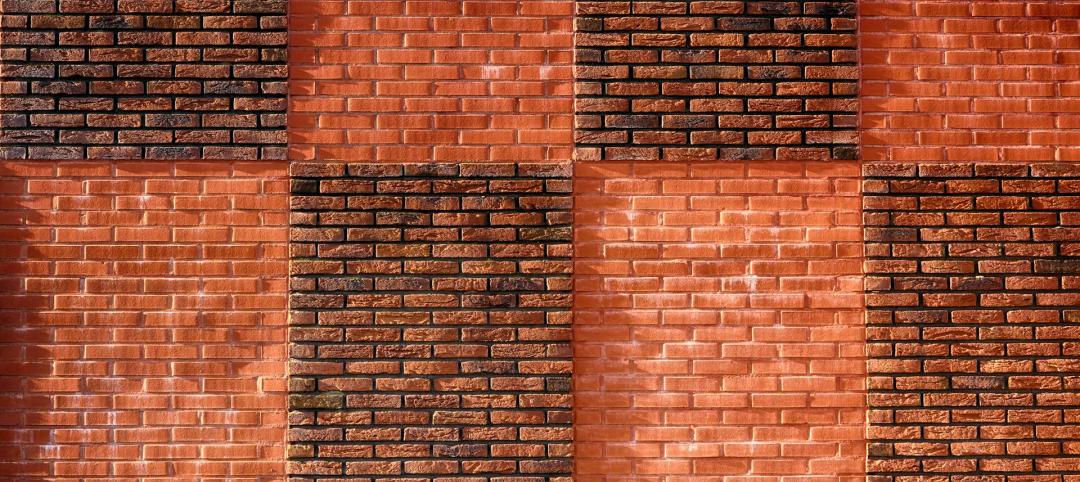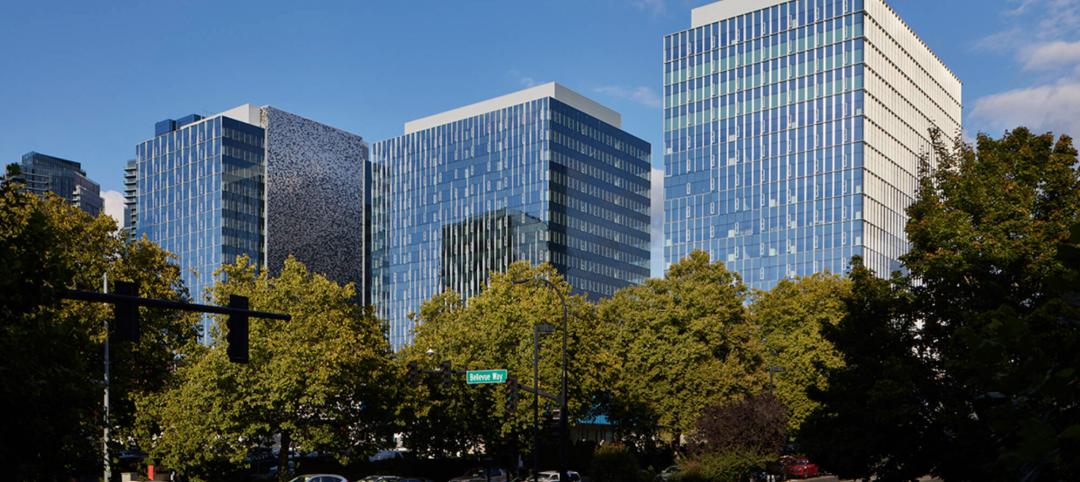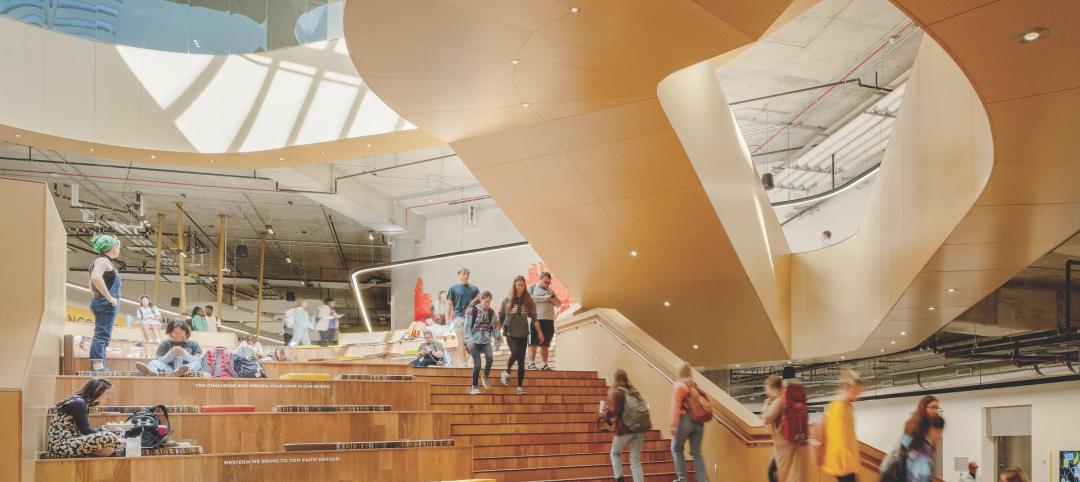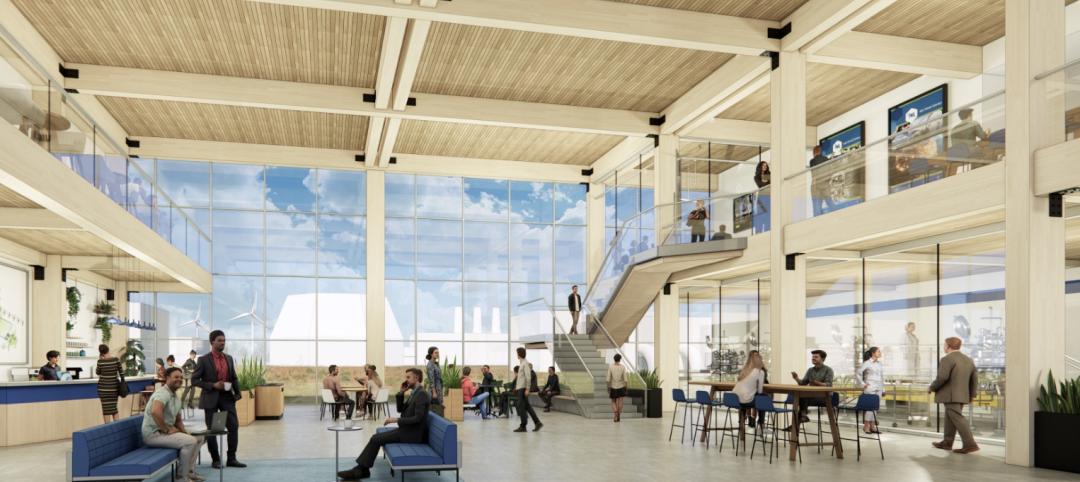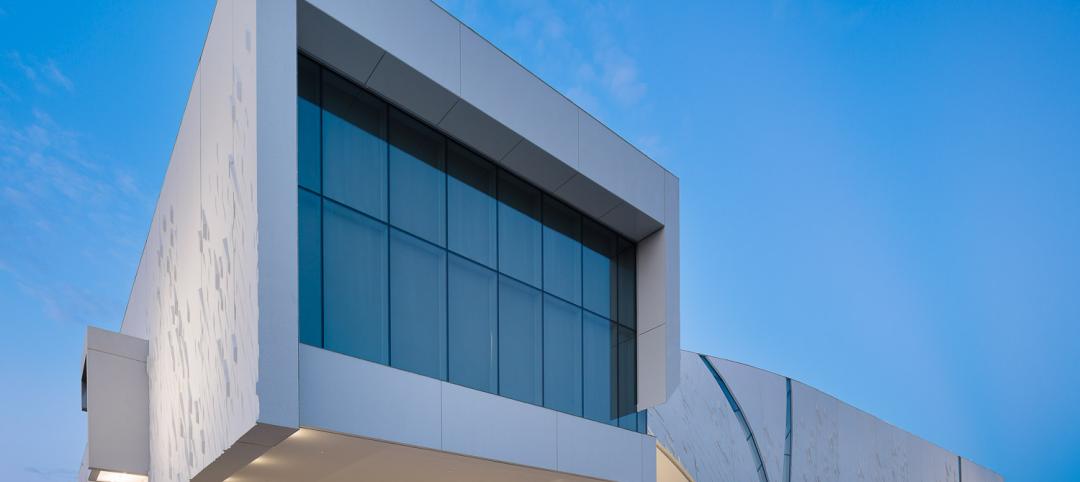Nadel Architects designed the new, world-class Dalian Sports Center, a massive 203-acre sports and entertainment complex located at 699 Lan Ling Rd., Ganjingzi District, Dalian, China on the Liaodong Peninsula adjacent to Korea.
The $1.5 billion project is the initial seed of urban development in the area. In addition to five major sports venues, the complex includes a 30-story, 440-room, 5-star Kempinski full-service hotel and conference center and a 40,500-square-meter athletes’ training facility and office building for coaches.
The sports complex, which hosted the China National Games upon completion of construction in September 2013, is designed to meet Olympic standards. The center is one of the only sports facilities in the world where all venues of this scale are incorporated on one site.
Venues include a 61,000-seat soccer stadium, an 18,000-seat indoor arena managed by AEG, a 9,600-seat tennis stadium, a 5,000-seat natatorium, a 3,000-seat baseball stadium, a comprehensive training and sports research facility as well as living quarters to accommodate athletes.

All photos: courtesy Nadel Architects
The city of Dalian prides itself as a “city of sports” with a specific reputation for being the “home of track and field,” “home of swimmers,” and the “city of soccer” in China.
Designed to accommodate numerous music concerts, sporting events, cultural and family events year-round, the new facility will not only serve as a regional sports center–propelling Dalian's world famous athletes to the forefront of training and international competition–but will also serve as an international tourist destination, entertainment venue and spiritually meaningful place to exercise, meditate and enjoy nature.
“In my 50-year career, this is the most remarkable project in which I’ve ever been involved,” said Herb Nadel, FAIA, founding principal of Nadel Architects. “I am terribly proud and excited to witness our team’s innovative design become a reality. Seeing this incredible center completed and built to world-class design standards is a true honor.”
Reinforcing the cohesiveness of the city's masterplan, the team, directed by Michael Hwa, planned the new year-round sports complex to connect residential neighborhoods with entertainment, retail and office space. The Dalian Sports Center creates a link through the heart of the city's newest development zone, becoming an anchor for the community and catapulting the city into a modern and connected city of the future.
Conceived as a “sports artery,” Dalian Sports Center incorporates an “S” shaped pathway as the main link between facilities during competition events. The pathway acts as a gently curving spine, crossing the site and connecting all the major venues like tendons connecting the muscles of the athletes.
Creatively blending landscape and the human form, the design effectively connects each of the sporting venues not only to each other, but also to the city's transportation infrastructure and to the community as a whole.
“The genesis behind the dynamic design of the facility was to capture the awe-inspiring speed, graceful lines and kinetic movements of competing athletes,” said Nadel. “Our design has connected the movement of the buildings with the muscles of the athletes – long graceful curves and lines – all providing a visual flow that captivates each person as they move through the complex.”
The main entrance to the sports center is a large, welcoming urban plaza that can accommodate up to 150,000 people. The cleverly landscaped plaza provides an immersive experience to the visitor through a necklace of intimately scaled spaces for relaxing, reading, meditation, tai chi, walking and enjoying music among seasonally changing gardens.
To conserve and reclaim water, these gardens have been ecologically engineered and terraced like traditional rice fields, flourishing year round with a variety of native plants and flowers.
The largest structure within the complex is the elliptical-shaped, 61,000-seat outdoor stadium, designed to accommodate soccer matches and other international sports competitions. Ethylene Tetrafluoroethylene (ETFE)–a transparent polymer popularized by Beijing’s Water Cube in the 2008 Summer Olympics–was used for the “skin” of the outdoor stadium due to its versatility.
The sophisticated material is lighter weight, transmits more light, insulates better and has a lower installation cost than glass or plastic. The stadium’s ETFE cushions, which are shades of white, grey and blue during the day, are illuminated with LED lights at night, displaying custom color patterns to represent the competing teams or to symbolize a particular event.
During winter, Dalian faces challenging weather and snow, requiring great ingenuity on the part of Nadel’s project team in the stadium’s design and materials used. To tackle this challenge, Nadel used Building Information Modeling (BIM) software to innovatively design, research and test the stadium exterior’s steel frame with a custom drainage system covered with a membrane of 2,745 ETFE cushions.
Adjacent to the outdoor stadium along the “S” pathway is the 18,000 seat indoor arena whose exterior features supple arching lines, representing an athlete’s muscles wrapping around a strong core. Managed by AEG, the indoor arena is used for an array of entertainment and sporting events including basketball, volleyball, table tennis, badminton, fencing, gymnastics, weight lifting, wrestling and martial arts, as well as a variety of music concerts.
The design of the natatorium was inspired by the waves of the sea. The natatorium boasts 5,000 spectator seats; a 10-lane, 50 meter pool for swimming, synchronized swimming and water polo competitions; a diving pool with 0.6, 2.6, 5.0, 7.5 and 10 meter diving platforms; an 8-lane, 50 meter warm up pool; and men’s and women’s locker rooms.
The 9,600-seat tennis stadium was designed to be both large and intimate, with every seat close to the action providing an unobstructed view of each event. The "seating bowl" of the arena sits within a live landscaped trellis structure, which embraces the spectators in field of green and light mirroring traditional European tennis venues and complementing the year-round landscaping of the “S” shaped pathway.
Nadel’s design team worked on a fast track schedule to complete the sports center in time for the 2013 China National Games. Nadel’s unique approach to the design and construction process allowed the entire project team to work together and develop an efficient timetable. The result is a facility that was completed under a tight deadline, without sacrificing the integrity of the design.
“This new facility is truly the architectural heart of the district, setting a benchmark for future developments that will serve the community,” said Nadel.
Joining Nadel on the project was Andrew Wolff, AIA, LEED® AP, senior designer; John Yang, project manager; and Michael Hwa, project director as well as a large team of designers and production staff.
Project Specifications
The 203-acre sports and entertainment complex features several areas for events and activities, including:
- 61,000-seat soccer stadium
- 18,000-seat indoor arena
- 9,600-seat tennis stadium
- 5,000-seat natatorium
- 3,000-seat baseball stadium
- 30-story, 440 room, 5-star Kempinski Hotel and media center
- 40,500-square-meter training and support research facility with 4 levels of athletic training space and 6 levels of office space for coaches
About Nadel Architects
For the past 40 years, Nadel Architects has provided comprehensive services ranging from architectural design, master planning and feasibility studies to complete interior design, planning and programming. Nadel is ranked among the largest architectural firms in the world (#60 per Building Design+Construction, Giant 300 list, 2012).
The company has completed more than 80,000 residential units, 30 million square feet of retail space, 600 office buildings, numerous hotels and resorts, and a variety of public and educational institutions, which have received more than 75 awards for design excellence. Headquartered in Los Angeles, the firm has designed a variety of projects located around the globe. For more information, please visit www.nadelarc.com.
Related Stories
AEC Tech Innovation | Oct 8, 2024
New ABC technology report examines how AI can enhance efficiency, innovation
The latest annual technology report from Associated Builders and Contractors delves into how artificial intelligence can enhance efficiency and innovation in the construction sector. The report includes a resource guide, a case study, insight papers, and an essay concerning applied uses for AI planning, development, and execution.
Healthcare Facilities | Oct 8, 2024
Herzog & de Meuron completes Switzerland’s largest children’s hospital
The new University Children’s Hospital Zurich features 114 rooftop patient rooms designed like wooden cottages with their own roofs. The project also includes a research and teaching facility.
Mixed-Use | Oct 7, 2024
New mixed-use tower by Studio Gang completes first phase of San Francisco waterfront redevelopment
Construction was recently completed on Verde, a new mixed-use tower along the San Francisco waterfront, marking the end of the first phase of the Mission Rock development. Verde is the fourth and final building of phase one of the 28-acre project that will be constructed in several phases guided by design principles developed by a design cohort led by Studio Gang.
Brick and Masonry | Oct 7, 2024
A journey through masonry reclad litigation
This blog post by Walter P Moore's Mallory Buckley, RRO, PE, BECxP + CxA+BE, and Bob Hancock, MBA, JD, of Munsch Hardt Kopf & Harr PC, explains the importance of documentation, correspondence between parties, and supporting the claims for a Plaintiff-party, while facilitating continuous use of the facility, on construction litigation projects.
Glass and Glazing | Oct 7, 2024
Pattern language: An exploration of digital printing on architectural glazing
Architectural Glazing has long been an important expressive tool which, when selected and detailed thoughtfully, can contribute to the successful transformation of architectural concepts to reality.
University Buildings | Oct 4, 2024
Renovations are raising higher education campuses to modern standards
AEC higher ed Giants report working on a variety of building types, from performing arts centers and libraries to business schools. Hybrid learning is seemingly here to stay. And where possible, these projects address wellness and mental health concerns.
AEC Tech | Oct 3, 2024
4 ways AI impacts building design beyond dramatic imagery
Kristen Forward, Design Technology Futures Leader, NBBJ, shows four ways the firm is using AI to generate value for its clients.
Laboratories | Oct 2, 2024
Trends in scientific research environments: Q&A with Flad's Matt McCord
As part of an ongoing series, Matt McCord, AIA, NCARB, LEED AP BD+C, Associate Principal with Flad Architects, discusses the future of the scientific workplace.
Museums | Oct 1, 2024
UT Dallas opens Morphosis-designed Crow Museum of Asian Art
In Richardson, Tex., the University of Texas at Dallas has opened a second location for the Crow Museum of Asian Art—the first of multiple buildings that will be part of a 12-acre cultural district. When completed, the arts and performance complex, called the Edith and Peter O’Donnell Jr. Athenaeum, will include two museums, a performance hall and music building, a grand plaza, and a dedicated parking structure on the Richardson campus.
Data Centers | Oct 1, 2024
10 biggest impacts to the data center market in 2024–2025
While AI sends the data center market into the stratosphere, the sector’s accelerated growth remains impacted by speed-to-market demands, supply chain issues, and design innovation necessities.


